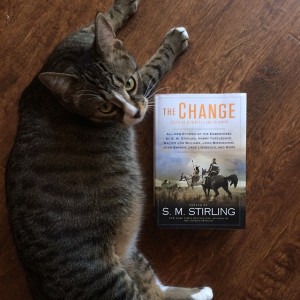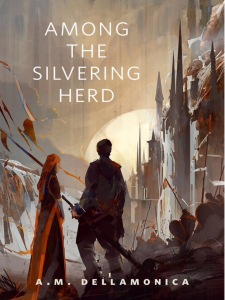 S.M. Stirling’s The Desert and the Blade
S.M. Stirling’s The Desert and the Blade launches today. It’s the latest in the Emberverse series, and the sequel to The Golden Princess
launches today. It’s the latest in the Emberverse series, and the sequel to The Golden Princess . (Which is, in turn, the sequel to many other novels.)
. (Which is, in turn, the sequel to many other novels.)
The Emberverse is the setting for Stirling’s anthology The Change: Tales of Downfall and Rebirth , which contains my story “Rate of Exchange,” about Finch, a Scout of many Badges of the Morrowland Pack.
, which contains my story “Rate of Exchange,” about Finch, a Scout of many Badges of the Morrowland Pack.
What follows is not going to be an unbiased review, is what I’m saying.
This is the latest book in a lengthy multigenerational saga, and my point in bringing it up is, no surprise, that I’m hoping you all might rush out right now, lay your hands on the novel, and read the living shit out of it. If you’ve already read The Golden Princess and its predecessors, you’re doing so already, and don’t need a sales pitch.
For everyone else: why should you jump into a well-established series?
The serious answer is because it’s about a friendship between two women, both barely adults and both grieving for their fathers. Orlaith is crown princess of the kingdom of Montival, while Reiko has become, in the wake of her father’s slaying, Empress of Japan.
They are a pair who have been isolated, their whole lives, by social rank. Though there are people who sincerely love them, neither has ever really had an equal. Royalty is a strange family business: their parents have always had to serve as their bosses as well as loving caregivers. Meanwhile, everyone else in their entire world is essentially an underling. But in The Desert and the Blade the princesses have run away from at least some of their responsibilities, not on a lark but to pursue an important task. They are on a Quest (capital Q definitely applies here) whose purpose is deadly serious. Conveniently, it also takes them away from the formalities of court life, and the restrictions of their day-to-day existence.
As they travel, fight and endure hardship together, they bond.
This seems like a situation quite removed from ordinary life, right? I mean, I dunno about all of you, but I can’t remember the last time I took my favorite vassals on a Quest. But who among us cannot relate to the other side of this experience–that discovery of a kindred spirit, and the early blossoming of a friendship where both parties discover not only that they share common ground… but that it’s ground that is terra incognita to everyone else they know?
What I’m saying is that books whose point is female friendship aren’t exactly thick on the ground. There’s a whole lot of “how she fell in love,” to be had in literature, but vanishingly little attention is paid to the platonic, sustaining, supportive–and, yes, sometimes problematic–ties that form between women. It’s also worthy of note that in Nicola Griffith’s examination of literary awards based on the gender of both authors and principal subjects, books by men about women and girls are virtually non-existent.
Steve should be encouraged, folks. He’s apparently doing something very anomalous.
Hovering in the back of my mind as I read The Desert and the Blade was another rarely-acknowledged and quite uncomfortable element of friendship: few, if any, are truly unconditional. Though they become close, for Orlaith and Reiko, “blood is thicker than water” can never merely be a saying. Their families are, to some extent, their entire respective nations. And though things go swimmingly between them in this novel, their saga isn’t over. The two of them owe a duty to their own that, by its very definition, cannot be put aside in favor of personal preferences. They can only be friends for as long as Montival and Japan have interests that align.
was another rarely-acknowledged and quite uncomfortable element of friendship: few, if any, are truly unconditional. Though they become close, for Orlaith and Reiko, “blood is thicker than water” can never merely be a saying. Their families are, to some extent, their entire respective nations. And though things go swimmingly between them in this novel, their saga isn’t over. The two of them owe a duty to their own that, by its very definition, cannot be put aside in favor of personal preferences. They can only be friends for as long as Montival and Japan have interests that align.
Whew! That’s all rather serious. Here’s the cover, and then I’ll offer up a few lighter reasons to get into The Desert and the Blade .
.


Here’s one: This book plays against type in a rather delightful way. I can accurately describe it as a book where two princesses get on their horsies, assemble some loyal followers, and go on a quest to find a magic sword! Whee! This makes it sound like anime, doesn’t it? C’mon. It’s princesses!
Yeah.
What we have here is pretty much the polar opposite of a rainbows and ponies marketing fantagasm like… oh, say Sailor Moon. Orlaith and Reiko are real heads of state, hefting heavy armor and making choices that affect thousands of people’s lives. It is not whimsy that drives them into the cannibal-infested realms of the city formerly known as Los Angeles. It’s deadly necessity.
In the unlikely imaginary situation where you’re thrown back to high school and someone sees you with this novel, and asks if you’re, like, really reading a princess book, you can look them in the eye and say “The euthanasia scene will rip your guts out, dude.”
Cannibal stand off! When the going gets tough, the tough stand a good chance of getting marinated, or at least slow-roasted. The stakes are high, because the steaks are people. Or soylent green.
Stirling’s Dunedain Rangers–did I mention these books have Dunedain Rangers, and it’s not a cheat, and it’s awesome?–are starting to forget that their not-too-distant ancestors were Tolkien fans. They are starting to believe the Elvish histories are, you know, history. This would totally happen.
Finally, there’s a thing with the post-Change inheritors of Topanga Canyon that makes me scream with joy. I can’t think of any way to tell you about it, though, without spoilers. Come back after you’ve read it and squee with me.
and “The Ugly Woman of Castello di Putti.”
and A Daughter of No Nation
. Some of you may have heard me characterize the pieces as the adventures of Doctor Who and her very pretty companion. I know January’s a way off (124 sleeps, to be precise!) but I hope you enjoy it.







 Fran Wilde’s first novel,
Fran Wilde’s first novel, 


